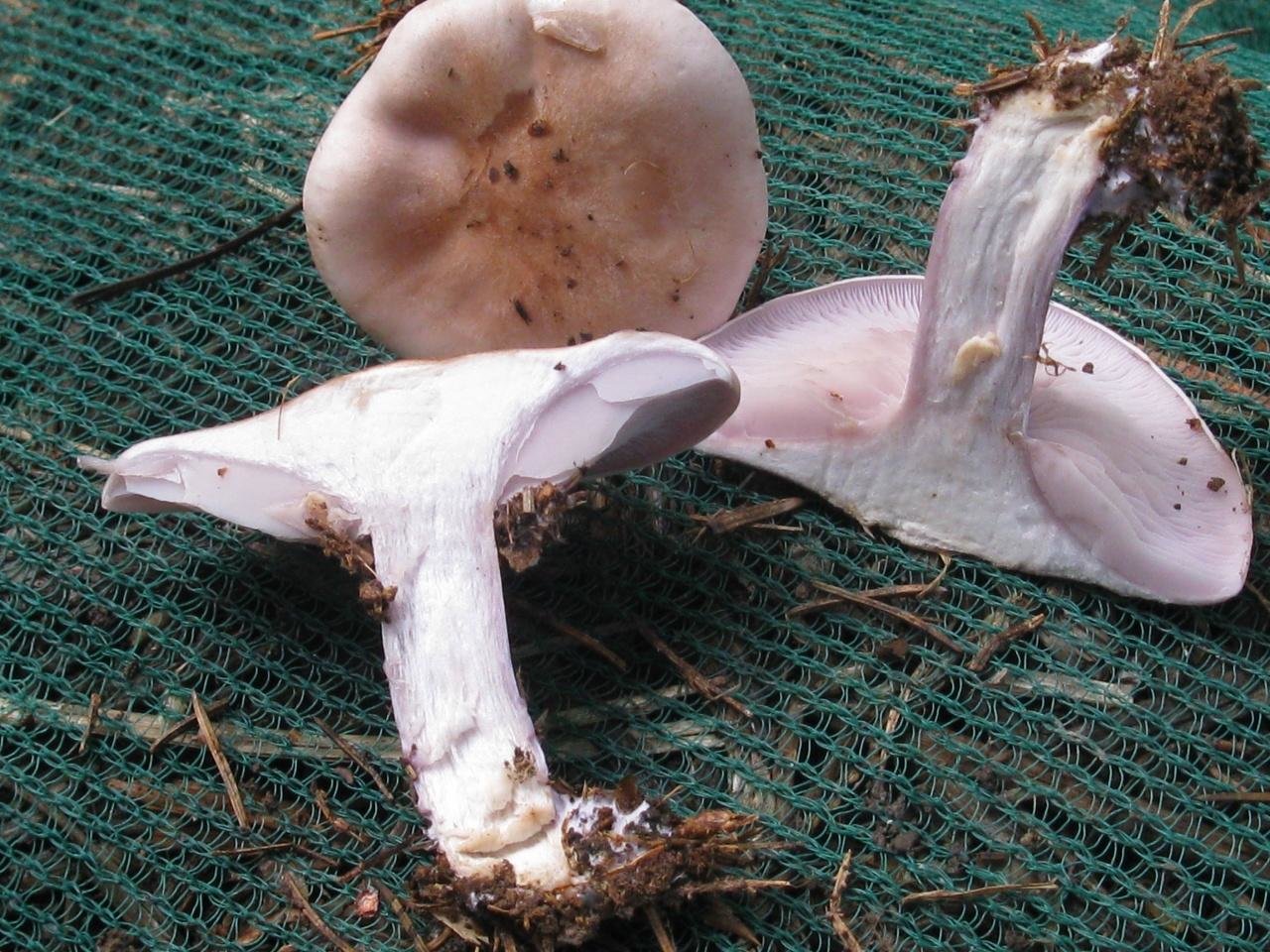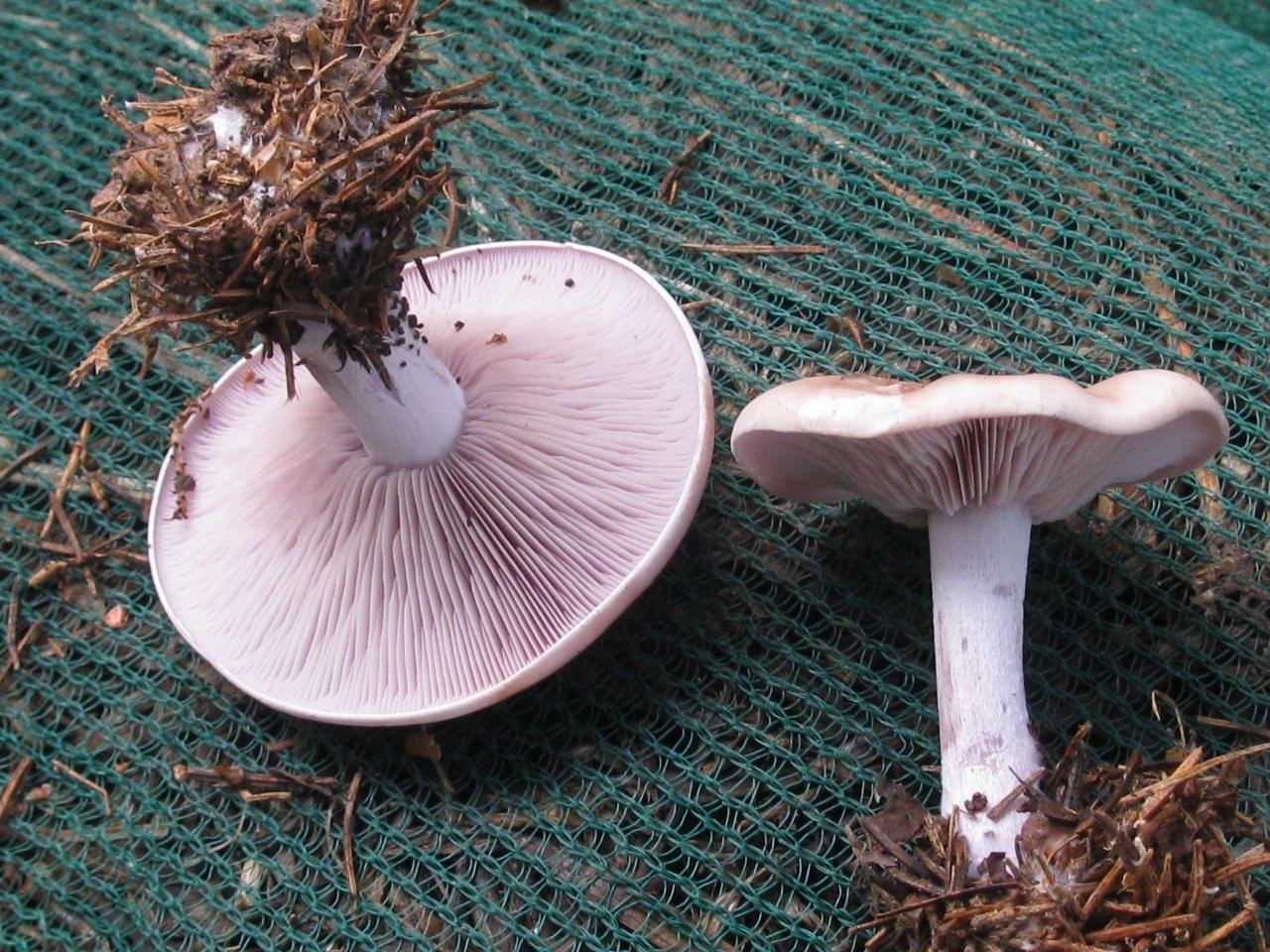Grayish-lilac rowweed (Lepista glaucocana)
- Division: Basidiomycota (Basidiomycetes)
- Subdivision: Agaricomycotina (Agaricomycetes)
- Class: Agaricomycetes (Agaricomycetes)
- Subclass: Agaricomycetidae (Agaricomycetes)
- Order: Agaricales (Agaric or Lamellar)
- Family: Tricholomataceae (Tricholomovye or Ryadovkovye)
- Genus: Lepista (Lepista)
- Type: Lepista glaucocana (Greyish-lilac rowweed)
- Row gray-blue
- Tricholoma glaucocanum
- Rhodopaxillus glaucocanus
- Clitocybe glaucocana

The cap is 4-12 (up to 16) cm in diameter, when young, from conical to hemispherical, then from flat-convex to prostrate, usually with a tubercle. The skin is smooth. The edges of the cap are even, turned inward when young, then folded over. The color of the cap is grayish, possibly with a lilac, lilac, or cream tint. The cap is hygrophanous, especially noticeable in mature mushrooms, it becomes brownish due to humidity.
The flesh is white or grayish, may be with a slight shade of the color of the stem / plates, in the stem at its periphery and on the bottom of the cap in the plates of the color of the stem / plates by 1-3 mm. The pulp is dense, fleshy, in old mushrooms it becomes watery in wet weather. The smell is not pronounced, or weak fruity or floral, or herbaceous, pleasant. The taste is also not pronounced, not unpleasant.

The plates are frequent, rounded towards the stem, notched, in young mushrooms almost free, deeply adherent, in mushrooms with prostrate caps they are noticeably notched, look like accreted due to the fact that the place where the stem passes into the cap becomes not pronounced, smooth, cone-shaped. The color of the plates is grayish, maybe cream, with shades of purple or lilac, more saturated than on top of the cap.

Spore powder beige, pinkish. Spores are elongated (elliptical), almost smooth or finely warty, 6.5-8.5 x 3.5-5 µm.
Leg 4-8 cm high, 1-2 cm in diameter (up to 2.5), cylindrical, can be expanded from below, club-shaped, can be curved from below, dense, fibrous. The location is central. From below, a litter grows to the leg, sprouted with mycelium with shades of the color of the leg, sometimes in large quantities. The stem is the color of the fungus plates, possibly with a powdery coating in the form of small scales, lighter than the color of the plates.
Grows in autumn in forests of all kinds with rich soil, and/or thick leafy or coniferous litter; on heaps of leaf humus and in places where foliage is brought; on rich soils in floodplain copses of rivers and streams, lowlands, ravines, often among nettles and shrubs. At the same time, the litter actively germinates with mycelium. It likes to grow along roads, paths, where there is a significant amount of leaf / coniferous litter. It grows in rows, rings, from several to dozens of fruiting bodies in a ring or row.
- Purple rowweed (Lepista nuda) is a very similar mushroom, in 1991 there was even an attempt to recognize the grayish-lilac variety of purple, but the differences were sufficient for it to remain a separate species, although a synonym Lepista nuda var. glaucocana. It differs in a paler color, and the main difference is the color of the pulp: in violet it is saturated purple throughout the entire depth, with rare exceptions, except for the light very center of the leg, and in the grayish-lilac color it appears only along the periphery in the leg and above the plates, and quickly disappears with distance to the center of the stem and away from the plates.
- Violet Row (Lepista irina) The mushroom is similar to the creamy form of the grayish-lilac row, it has a strong smell.
- The lilac-legged rowing (Lepista saeva) It differs, firstly, in the place of growth – it grows in meadows, along river banks, along the edges, in glades, in the grass, and the grayish-lilac rowing in the forest with thick leafy or coniferous litter. Although, these species can intersect in habitat at the edges. In the lilac-legged row, the characteristic lilac color appears only on the stem, but never on the plates, and in the grayish-lilac color of the stem, it is identical to the color of the plates.
Conditionally edible mushroom. Delicious. It is completely similar to the purple row. Heat treatment is necessary because the mushroom contains hemolysin, which destroys red blood cells (like the purple row), which is completely destroyed by heat treatment.
Photo: George.









